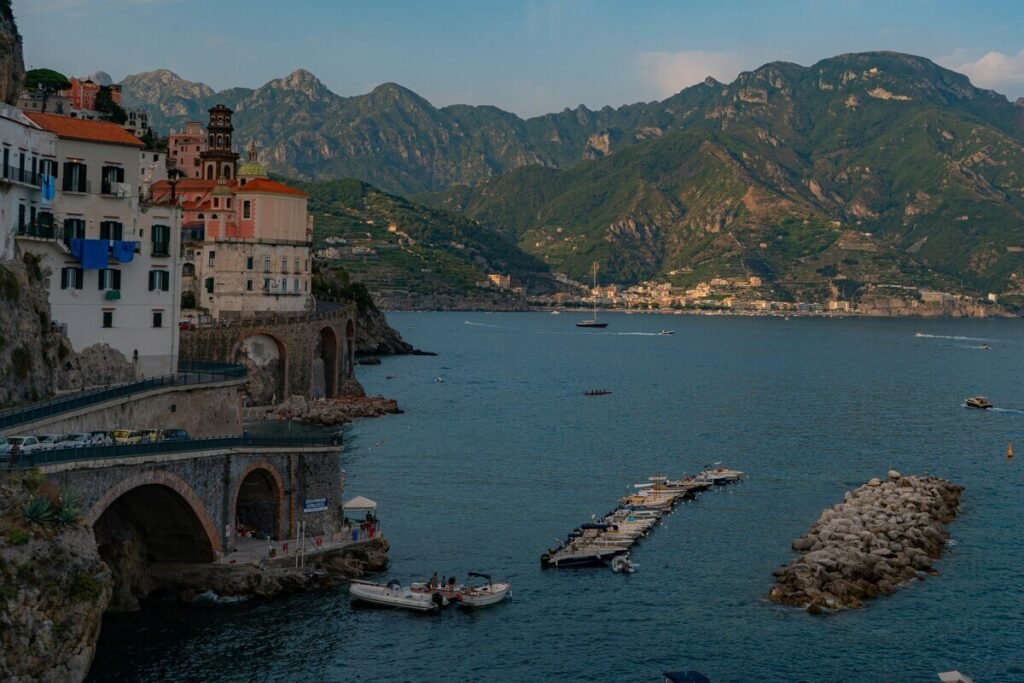Planning a Trip to Rome?
Here’s Your Ultimate Travel Guide
Planning a trip to Rome can be one of the most exciting experiences. Well, at least it was for me. This city has a lot to offer – a variety of ancient history, modern culture, and delicious Italian food. Rome was one of the three European cities I always dreamed of visiting.
I think Rome has something for everyone, whether you’re a history buff, an art lover, or a foodie. That is why I included all the most exciting things in this guide. You will also find some practical tips for your trip to Rome.
Why Is It Worth to Take a Trip to Rome?
While visiting, you will find that Rome blends the past and the present. Just walking through the streets, you can explore ancient ruins, Renaissance architecture, and lively neighbourhoods, all within a few blocks. No wonder a trip to Rome is on many travellers’ bucket lists.
What to Expect?
The main thing you can expect during your trip is enjoying the past and the modern present all in one place. Rome offers various attractions for different people. You will see inspiring monuments like the Colosseum and the Vatican Cathedral. Don’t forget to rest in charming piazzas and enjoy fantastic food with many choices.
Unfortunately, the city comes with busy streets, crowds, and even pickpocketing. You will need careful planning to ensure you make the most of your time there.
Prepare for Your Trip to Rome
Good preparation for travelling is key. Fortunately, I like to plan my trips. Firstly, you should book accommodations and flights in advance. Then, organise your itinerary and pack practically or at least create a list of what to pack. It will save you from last-minute stress. And that is what this Rome trip guide is for.
Plan the the Trip to Rome Itinerary
Booking flights early can help you find the best deals, especially if you’re visiting during the high season (spring and summer). Rome has two main airports: Fiumicino (Leonardo da Vinci Airport) and Ciampino, with Fiumicino being the major airport for international travellers.
As for accommodation, location is key. Staying near central areas like Piazza Navona, Trastevere, or the Vatican gives you easy access to the city’s attractions. But these locations may be a bit pricier. Rome has everything from luxury hotels and boutique Airbnb to budget hostels. So evaluate your budget and book early to get the best possible deal.
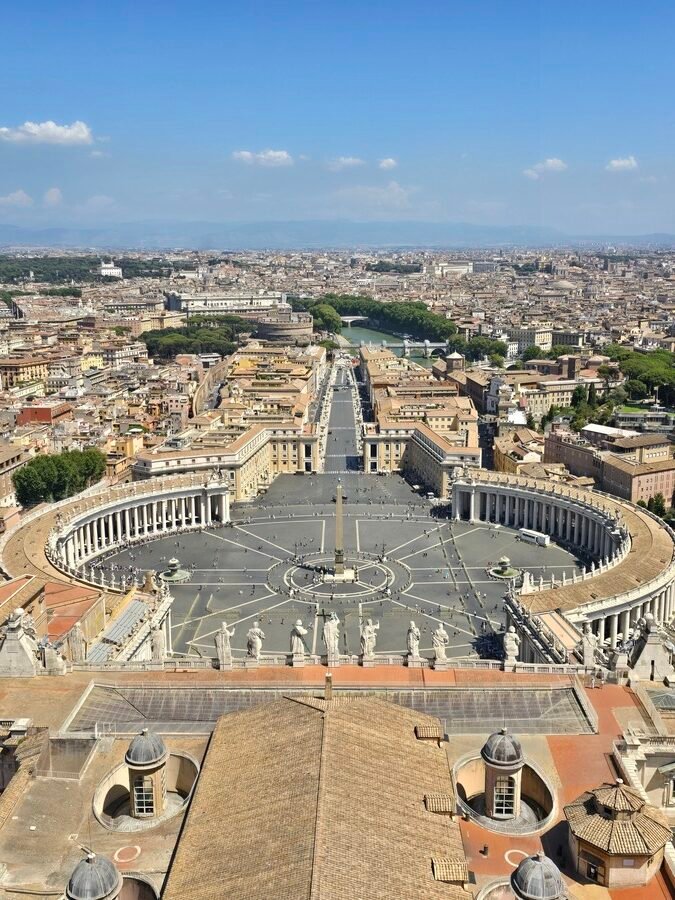
Pack for the Trip to Rome
The weather in Rome can vary depending on the season. Summers are hot, so pack for your trip to Rome light. Pack breathable clothing, comfortable footwear, a hat, sunglasses, and sunscreen. There are water fountains all over Rome, so don’t forget to pack your water bottle. Or you can buy one in Rome. Winters are mild but can still be chilly, especially at night, so a warm jacket is essential. No matter the season you visit, comfortable walking shoes are a must. Rome is best explored on foot, and the cobblestone streets can be hard on your feet if you’re not prepared.
Get Around Rome
Rome’s public transportation has buses, trams, and metro lines. But many attractions are close enough to walk between. As I mentioned before, walking is often the best way to explore the city. This way, you won’t miss charming streets and hidden treasures. But I would suggest using Rome’s metro system for longer distances. It’s efficient, though limited, compared to other cities. Taxis are also available, but they can be a bit more expensive. Alternatively, you can rent electric scooters or bikes for short-distance travel.
Arrival in Rome
Navigating from the Airport
If you’re flying into Fiumicino Airport, the fastest way to reach the centre of Rome is via the Leonardo Express train. It takes about 30 minutes to get to the main station – Termini. You can take a bus, metro, or taxi to your accommodation from there. If you’re flying into Ciampino Airport, you have 3 options to reach the city: a train, which takes about 15-20 minutes; a bus, which takes around 40 minutes; or a taxi, which can be expensive.
Checking Into Your Accommodation
Checking into your accommodation is usually a smooth process. But keep in mind that check-in times at hotels or Airbnb in Rome can be later than expected. If you arrive early, you can ask if you can drop off your luggage and explore the city while you wait for your room to be ready.
Exploring Iconic Landmarks:
A Walking Tour for Your Trip to Rome
Now, let’s move to the most exciting part – exploring the city. Most famous landmarks are close to one another. So, a self-guided walking tour will allow you to embrace ancient history and modern culture at your own pace. Let’s start with a guide to some of the most iconic stops on your walking tour of Rome.
Spanish Steps
One of the most recognisable spots you should visit during your trip to Rome is the Spanish Steps. These 135 steps start from Piazza di Spagna to Trinita dei Monti Church at the top. Architect Francesco de Sanctis designed the steps in the 18th century. Sitting on the steps was once a tourist’s favourite activity. However, recent regulations have prohibited sitting on the steps to preserve the monument. Instead, walk to the top for a panoramic view of the Piazza di Spagna. I suggest visiting these steps early in the morning before the crowds arrive. But this goes almost to all the landmarks as Rome is one of the most visited cities.
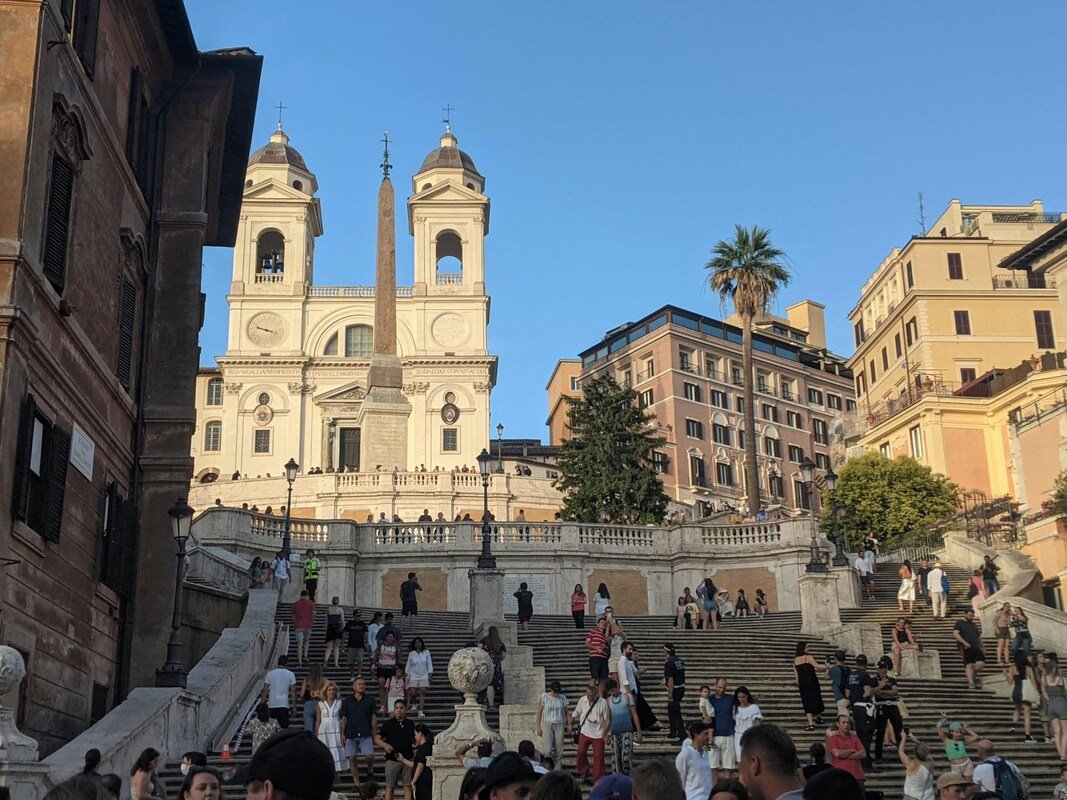
Right in front of the steps, you will find Fontana della Barcaccia. It’s a 17th-century fountain designed by the father of Baroque sculptor Gian Lorenzo Bernini. The fountain, shaped like a half-sunken ship, is a tribute to the flooding of the Tiber River.
You Have to See Trevi Fountain During Your Trip to Rome
Just a 10-minute walk from the Spanish Steps will bring you to the Trevi Fountain. It is definitely Rome’s most famous and beautiful fountain. Nicola Salvi designed the fountain in the 18th century. This massive Baroque fountain marks the end of the ancient Aqua Virgo aqueduct, which supplied water to the city. The fountain has a majestic statue of Neptune riding a chariot led by two sea horses. It symbolises the power of the sea.
You may have heard of the tradition of throwing a coin into the fountain. It dates back to ancient times and promises that you will one day return to Rome. Actually, tourists throw around €3,000 in coins into the fountain every day. The city representatives collect them and donate them to charity. I would suggest visiting the fountain early in the morning or late in the evening to avoid the crowds.
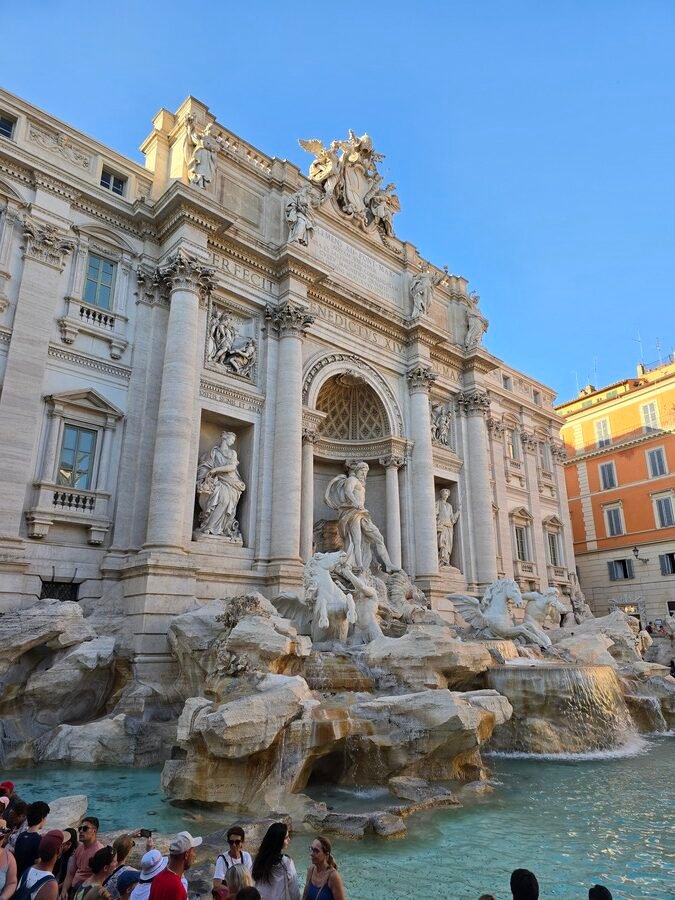
Galleria Alberto Sordi
If you want to change your pace, head to Galleria Alberto Sordi. It’s a shopping gallery that was built in the early 20th century, and its architecture is Art Nouveau. In the gallery, you can spend some time shopping, get to know Italian fashion brands and bookstores or relax in one of many cafes. Even if you don’t want to shop, the building’s architectural details are worth a visit.
Column of Marcus Aurelius
Next, visit the Column of Marcus Aurelius in Piazza Colonna. This towering monument was built in honour of the Roman Emperor Marcus Aurelius to celebrate his military victories in the Marcomannic Wars. If you come close, you will see the carvings spiralling around it, telling the story of the emperor’s marches.
Temple of Hadrian
Walk a few minutes from the Column of Marcus Aurelius and see the Temple of Hadrian. It was originally built in 145 AD to honour Emperor Hadrian. Eleven of the original Corinthian columns still stand. This temple is now partially incorporated into a modern building. This gives a blend of the ancient and modern. Today, the building houses Rome’s stock exchange.
Chiesa di Sant’Ignazio di Loyola
One of the lesser-known treasures in Rome is the Chiesa di Sant’Ignazio di Loyola. It’s a stunning Baroque church dating back to the 17th century. The church is famous for its frescoes, which Andrea Pozzo created. When you step inside, your eyes go straight to the masterpiece on the ceiling. It creates the illusion of a grand dome. So, stand on the marble disk marked on the floor directly beneath this “fake dome” and look up. Pozzo’s created perspective can fool anyone into thinking you’re looking at a three-dimensional architectural feature. Many visitors leave unaware that no actual dome exists. Don’t miss the other artistic highlights – explore the richly decorated chapels and the intricate altar.
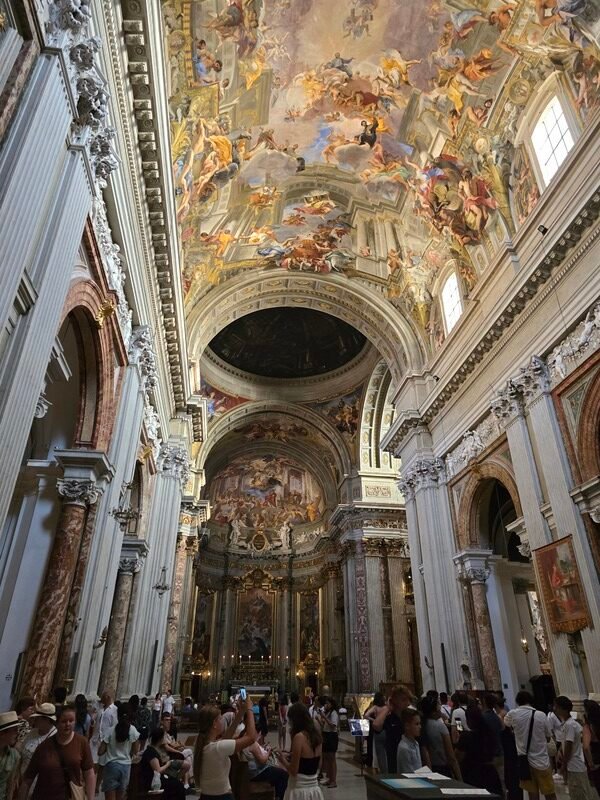
Visit the Pantheon During Your Trip to Rome
Next stop – the Pantheon. It’s one of Rome’s most iconic landmarks, standing here for nearly 2,000 years. The Pantheon was originally built as a temple to all the Roman gods. Later, it was converted into a Christian church. It remains the best-preserved ancient Roman building in the city. The massive dome architecture continues to inspire architects around the world.
A circular opening at the top of the dome – the Pantheon’s oculus, allows natural light to fill the interior. Standing inside and watching the light shift throughout the day is an amazing experience. Unfortunately, not many people can dedicate a day to this experience. Don’t forget to explore the tombs of notable figures, including the painter Raphael.
Largo di Torre Argentina
Next on your list is to visit Largo di Torre Argentina, an archaeological site dating back to the Roman Republic. This square is home to the ruins of four ancient temples and part of Pompey’s Theatre, where Julius Caesar was famously assassinated in 44 BC. But most people like to visit this landmark not because of it. Among the ruins live dozens of stray cats. But don’t worry – volunteers are taking care of them.
Campo de’ Fiori Market
After enjoying watching cats on your one stop during your trip to Rome, you should visit the Campo de’ Fiori Market. This market has been a gathering place since the 15th century. Here, you can find stalls selling fresh produce, local cheeses, meats, and flowers. Try out some delicious local snacks or have lunch.
Campo de’ Fiori is surrounded by cafes and restaurants where you can sit and enjoy the lively atmosphere. The square transforms into a popular nightlife spot in the evening, with bars and eateries bustling with locals and visitors alike. Have that in mind when wondering what to do in the evening.
Vatican City – Essential to Visit During Your Trip to Rome
One of the most amazing sites is visiting Vatican City, the smallest independent state in the world. It’s home to some of the most significant religious landmarks. Start your visit to St. Peter’s Basilica, one of the top things to see in Vatican City. The Basilica is a stunning example of Renaissance architecture. It features the iconic dome designed by Michelangelo. Inside, you can admire exquisite artworks, including Michelangelo’s Pietà and Bernini’s Baldachin. Don’t forget to climb to the top of the dome and enjoy breathtaking views of the city. It’s one of the most beautiful views in Rome.
Next to the basilica is St. Peter’s Square, designed by Bernini in the 17th century. Here, you can enjoy the impressive colonnades surrounding the square, which features an Egyptian obelisk at its centre. It’s actually one of my favourite spots in all of Rome.

Another highlight in this state is the Vatican Museums, where you can explore collections of art and historical artefacts. Don’t miss the Sistine Chapel, famous for its ceiling painted by Michelangelo, depicting scenes from the Book of Genesis. I would suggest booking your tickets in advance or visiting during off-peak hours to avoid long lines.
Castel Sant’Angelo
Walk 15 minutes from Vatican City to reach Castel Sant’Angelo, a fortress built as a mausoleum for Emperor Hadrian. Over the centuries, it has served various purposes, including a papal residence and a fortress. Inside, you can explore the museum, which showcases artefacts and artwork related to its history. After exploration, move up to the castle rooftop terrace to admire panoramic views of the Tiber River and the city.
You should spend some time strolling along the Tiber River during your trip to Rome. Enjoy the fresh air, beautiful bridges and surrounding scenery.
Villa Borghese Gardens
If you need a break from the city, head to the Villa Borghese Gardens. No, actually, head to the gardens even if you don’t need a break. This park is perfect for a stroll, picnic, bike, or rowboat renting. The gardens are full of beautifully manicured lawns, fountains, and sculptures. Within the park, you can visit the Galleria Borghese, an art museum housed in a stunning villa. It features works by Caravaggio, Raphael, and Bernini.

The gardens also provide breathtaking views of Pincio Hill, where you can enjoy a romantic sunset over the city. They’re free to visit. And if you’re on a tight budget, find 15 free things to see in Rome.
Colosseum, Roman Forum, and Palatine Hill
No trip to Rome is complete without a visit to the Colosseum, an iconic symbol of ancient Rome. This massive amphitheatre was built in AD 80 and could hold up to 80,000 spectators. It was the site of gladiatorial contests and public spectacles. Walking through the Colosseum, you can feel its grandeur. You can visit different places in the Colosseum, like the Arena and underground, but they require different tickets. So don’t forget to book your tickets – they are usually bought out 2 weeks in advance.
Next to the Colosseum is the Roman Forum. It used to be a marketplace and the centre of public life. Here, you can see the ruins of important structures, including the Temple of Saturn and the Arch of Titus. Explore the Forum to gain insight into the daily life of ancient Romans.
Nearby, Palatine Hill is one of Rome’s seven hills and offers beautiful views of the Forum and the Circus Maximus. According to legend, it’s the site where Romulus founded the city. Wander through the ruins of imperial palaces and gardens.
The Seven Hills of Rome
The city was built on seven hills: Palatine Hill, Capitoline Hill, Aventine Hill, Caelian Hill, Esquiline Hill, Viminal Hill, and Quirinal Hill. Each hill has its unique history. For instance, Capitoline Hill is home to the Capitoline Museums, where you can explore ancient Roman art. Aventine Hill offers a peaceful atmosphere with beautiful gardens and a city view from the Orange Garden. Explore as many hills as possible during your trip to Rome.
Find all the best highlights and an itinerary if you plan to spend just 1 day in Rome.
Beyond the Trip to Rome:
Discover the Hidden Gems
While Rome’s iconic landmarks are certainly worth visiting, the city is also rich with hidden gems that offer unique experiences away from the tourist crowds. These less-known spots provide a glimpse into the local culture, history, and daily life of Romans. Here are some hidden gems to explore during your trip to Rome.
Trastevere
Trastevere is one of Rome’s most charming neighbourhoods, just across the Tiber River from the historic centre. The narrow, cobblestone streets are filled with colourful buildings, lively piazzas, and ivy-covered facades. I suggest visiting this neighbourhood in the late afternoon and evening, as this is when it comes to life.
Trastevere is known for its local eateries and trendy cafes. Visit Piazza di Santa Maria, where you can find the Basilica di Santa Maria. This ancient church has beautiful mosaics and a lively atmosphere, especially during evening services. Oh, and don’t forget to grab a gelato.
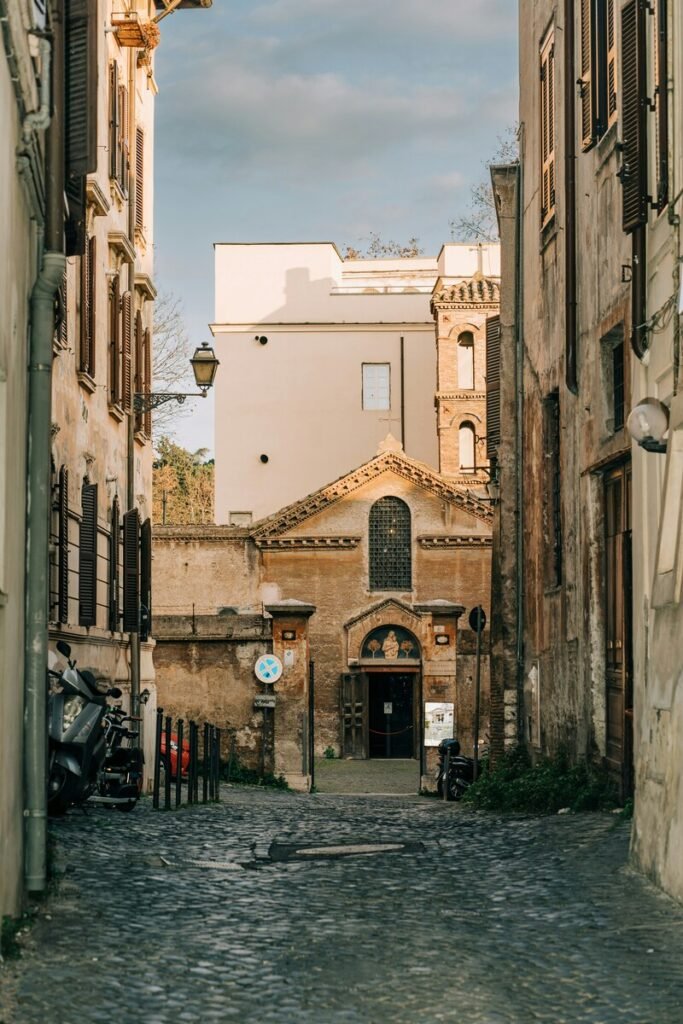
Tiber Island
Tiber Island is a small, crescent-shaped island in the middle of the Tiber River. It’s easily accessible via the bridges. The island is a perfect spot to relax and enjoy scenic views of the river. Here, you can escape the crowds, have a picnic, or simply sit and enjoy the quiet surroundings.
Testaccio – A Truly Hidden Gem on a Trip to Rome
If you want to taste more modern Roman life during your trip to Rome, head to the Testaccio neighbourhood. Testaccio is south of the historic centre. It is known for its authentic culinary scene and food markets. The area has a rich history as a traditional working-class neighbourhood. Here, you will find some of Rome’s best local eateries.
Mercato di Testaccio is the heart of the neighbourhood, where you can sample local delicacies and fresh produce. You’ll find stalls selling everything from artisanal cheeses to handmade pasta here. Be sure to try traditional Roman dishes like Cacio e Pepe and Pasta alla Carbonara at one of the many nearby restaurants.

Villa Doria Pamphili
If you love greenery, Villa Doria Pamphili is the perfect place for you. It’s Rome’s largest landscaped public park, located near Gianicolo Hill. The park has beautiful gardens, walking paths, and stunning fountains. Another place for you to get away from the crowded areas.
San Lorenzo
San Lorenzo is an up-and-coming neighbourhood known for its vibrant atmosphere and youthful energy. Located near the University of Rome, this area has trendy cafes, bars, and street art. If you want to experience the local art scene, with contemporary art galleries and exhibitions, it’s the perfect place.
Check this article to learn how to spend perfect 2 days in Rome: a detailed itinerary.
Culinary Experiences During Your Trip to Rome
Rome is the perfect place for you if you’re a foodie. Italy’s capital is famous for its food, and no trip to Rome is complete without indulging in the city’s culinary delights.
Traditional Roman Dishes
Rome’s food scene is centred around simple, fresh ingredients. Here are some must-try dishes for you:
Cacio e Pepe: It’s a classic Roman pasta dish made with pecorino cheese and black pepper.
Carbonara: Another popular pasta dish made with eggs, guanciale (pork cheek), and pecorino. You know you have to try pasta in Rome.
Roman-Style Pizza: Known for its thin, crispy crust, Roman-style pizza can be a quick but delicious meal.
Coda alla vaccinara: It is an oxtail stew cooked in a tomato-and-wine broth. It is flavoured with raisins, pine nuts, cloves, and fresh-ground black pepper.
Gelato: No trip to Italy is complete without tasting authentic Italian gelato. Try flavours like pistachio or hazelnut.
Dining Etiquette and Tips
In Rome, tipping is not expected but appreciated. Most locals round up the bill or leave a small amount as a gesture of thanks. Standing at the bar rather than sitting at a table when ordering coffee is common. And actually, it’s cheaper this way.
To avoid touristy restaurants, look for places where locals eat. Small trattorias away from touristic trails offer the best, most authentic meals.
Food Markets
I have already covered several markets, but to experience local flavours, you must visit at least one, like Campo de’ Fiori or Mercato Testaccio. Sample fresh produce, cheeses, and cured meats at these markets. Try local delicacies such as supplì (fried rice balls) or porchetta (roast pork). Markets are a great place to pick up unique souvenirs like balsamic vinegar, truffle products, or artisanal olive oil. Whether planning a picnic in one of Rome’s parks, like Villa Borghese or Villa Doria Pamphili, or just wanting to snack while exploring, the markets offer plenty of authentic Italian treats. And don’t forget to interact with local vendors to experience Roman daily life.
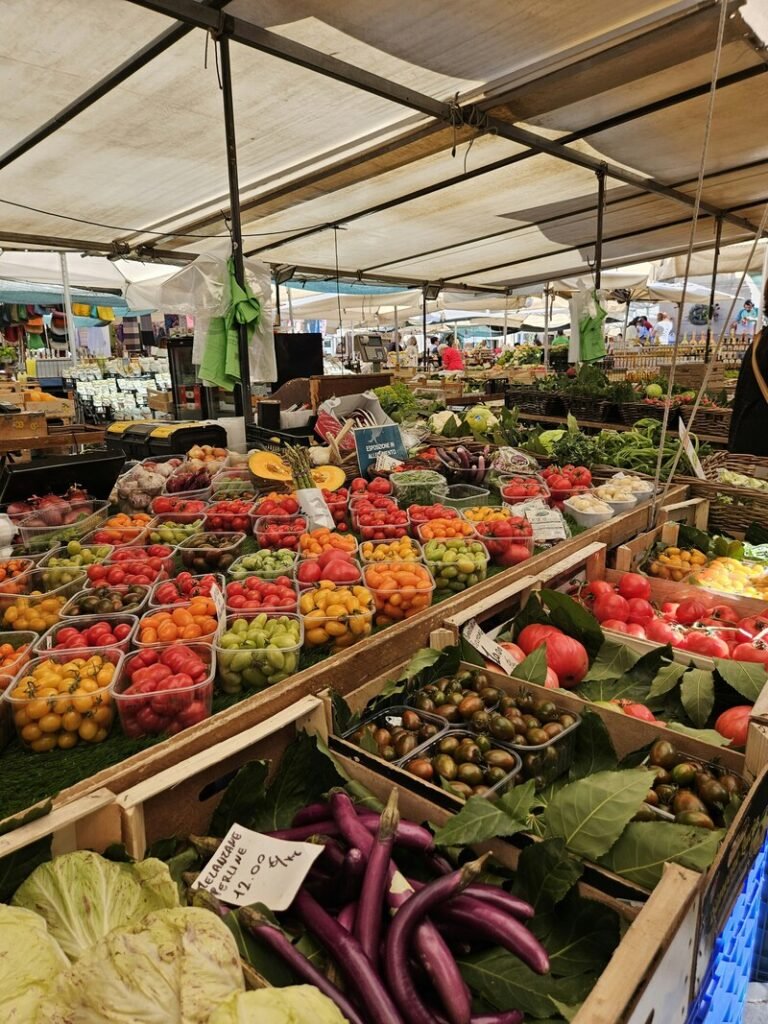
If you’re planning to stay 3 days in Rome, read this article to learn everything you need to know.
Rome by Night
I know you will be tired after a whole day of exploring, but you must experience Rome at night. The city’s landmarks are beautifully illuminated, and the streets are quieter.
Nighttime Walks
A nighttime stroll through Rome is one of the best ways to experience a different side of the city. Walk along the Tiber River and across its historic bridges, or visit landmarks like the Colosseum and Piazza Navona. After dark, it is for a more serene experience.
Enjoy Evening Aperitivo During Your Trip to Rome
Have at least one night during your trip to Rome to slow down and enjoy an aperitivo with a sunset view from a rooftop. Aperitivo is a pre-dinner drink and snack tradition in Rome. It’s a relaxing way to enjoy the evening and socialize with locals. Many bars offer special aperitivo menus that include a drink and light snacks for a set price. Look for rooftops to enjoy the sunset and city view from above.
If you are planning to stay less than a week in the Eternal City, read this article to find the perfect itinerary for 4 days in Rome.
Day Trips from Rome
While there’s plenty to see within Rome, if you’re staying longer, consider taking a day trip from Rome. Explore nearby towns and attractions. These excursions offer an experience of different Italian culture, history, and natural beauty.
Ostia Antica
Just a short train ride from the city centre, Ostia Antica is an ancient Roman port city that served as Rome’s main harbour. Founded in the 4th century BC, Ostia was once a thriving city for trade and commerce.
The site has preserved ruins, including homes, temples, baths, and a forum. Take a walk through the ancient streets and enjoy a slower mode. The on-site museum has various artefacts in the area, including mosaics, statues, and everyday items from Roman life.
Explore Tivoli During Your Trip to Rome
Tivoli is located about 30 kilometres from Rome. The city is renowned for its stunning villas and gardens. This town is a great place for a perfect day trip, especially for those interested in art, architecture, and nature.
A UNESCO World Heritage Site, Villa d’Este is famous for its magnificent gardens and fountains. The villa was built in the 16th century for Cardinal Ippolito d’Este, showcasing the grandeur of Renaissance architecture. The gardens are full of greenery, fountains, and beautiful sculptures. It’s a perfect spot for a leisurely stroll.
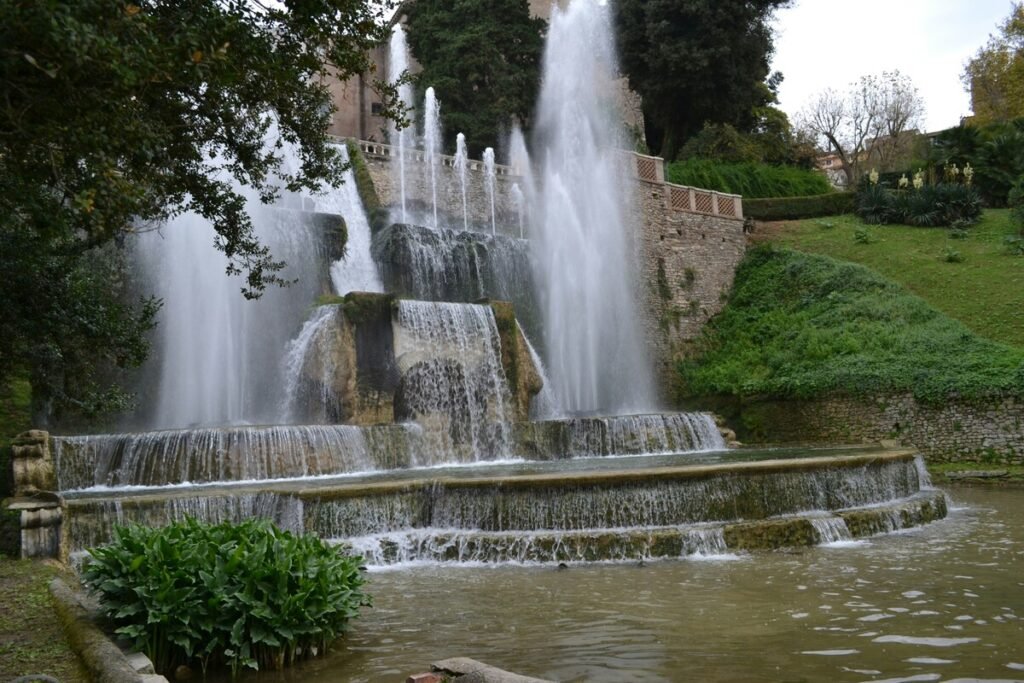
Hadrian’s Villa (Villa Adriana) is another UNESCO World Heritage Site. This archaeological complex was Emperor Hadrian’s retreat. It includes palaces, temples, and gardens. The layout of Hadrian’s Villa was inspired by various architectural styles from around the empire.
Castelli Romani
The Castelli Romani are a collection of hill towns located southeast of Rome. They are known for their beautiful landscapes, historical significance, and culinary offerings. If you’re looking for a quick escape from the city during your trip to Rome, this is the ideal choice.
Perhaps the most famous town in the area, Frascati, is known for its white wine and beautiful villas. Here, you can explore the town’s streets and sample local wines at one of the many enotecas (wine shops). Don’t forget to visit the beautiful Papal Villa and its expansive gardens.
Known for its picturesque lake, Nemi is famous for its wild strawberries. This village offers beautiful views and a peaceful atmosphere. Sample delicious strawberry desserts or buy jars of homemade preserves. It’s the perfect place to break from the city noise.
Albano Laziale is on the edge of Lake Albano. It’s known for its beautiful historical centre, churches, and scenic views from the hilltops. Lake Albano is the perfect place to have a picnic or enjoy a lakeside walk.
Genzano di Roma is famous for its annual Infiorata, a flower festival held in May. Have that in case you love flower festivals. During this festival, natives adorn the streets with floral carpets. Genzano is also known for its traditional pastries, especially torta di mele (apple pie).
Amalfi
An Amalfi day trip from Rome is one of the most popular choices for a short getaway. The coast stretches over 50 kilometres along the southern Tyrrhenian Sea and is home to 13 towns. This UNESCO World Heritage site is known for its cliffs, crystal-clear waters, and vibrant villages.
Each destination along the coast, from Amalfi to Positano and Ravello, has its own unique appeal. Enjoy your day at one of the longest beaches on Maiori and explore its authentic fishing village. Nature lovers can hike to the Path of the Gods (Sentiero degli Dei) near Praiano. Visit the Villa Rufolo in Ravello. This 13th-century villa showcases Moorish and medieval architecture. And it is worth visiting the gardens for a relaxing stroll. This article about Amalfi day trip from Rome covers all the needed information for the perfect trip.
Rome will leave a lasting impression. Its history, culture, and atmosphere make it one of the world’s most visited destinations. Whether it’s your first time or a return visit, a trip to Rome will definitely create unforgettable memories. Enjoy!
Practical Tips for Your Trip to Rome
Rome is a popular tourist destination, so it can get crowded, especially at major attractions. However, planning before your trip to Rome allows you to enjoy the city while minimising the time spent in lines and crowded areas. Here are some valuable tips to help you navigate the Eternal City effectively.
Best times to visit popular attractions. It’s best to visit popular attractions early in the morning or late in the evening to avoid crowds. Here are some specific recommendations:
– Vatican Museums: The lines to visit St. Peter Basilica and Vatican Museums can take up to 3 hours. Yes, I am not joking. So aim to arrive even before the museum opens. Or visit during the last two hours before closing.
– Colosseum: Consider booking a guided tour that includes early access. Otherwise, visiting just after opening or close to closing time can help you avoid peak crowds.
– Trevi Fountain: Early morning visits, around sunrise, provide a peaceful experience and a great photo opportunity without crowds of people. Usually, even after sunset, there are lots of people gathering around Trevi Fountain, and it’s hard to enjoy the view.
– Pantheon: This site can get busy during the day. Try to visit during the late afternoon when many tourists have moved on to other areas.
Avoiding peak travel times: If possible, avoid planning your trip to Rome during peak tourist seasons, typically from late spring to early fall. Consider travelling during late fall or early spring. The weather will not be as hot, and there will be fewer crowds.
Utilise public transport: Consider using public transport to navigate the city. The metro, buses, and trams can help you reach attractions more efficiently. The public transport system is generally reliable and can save you time.
Additional Tips
Take advantage of tours: Guided tours often allow you to skip lines and provide insightful information about the sites. Look for small-group tours or private guides who can lead you to less-known spots. Also, look for Free Tours to investigate the city for free. They are tip-based, so you can save some money and see the main tourist attractions in a few hours. Whenever I go to a new city, I always book a tour with Sandman’s free walking tour.
Attend local events and festivals: To immerse more in the local vibe, check for events, festivals, or exhibitions during your visit. These can offer unique cultural experiences and allow you to engage with locals away from tourist-heavy areas.
Stay hydrated and take breaks: Rome can be hot, especially in the summer. Stay hydrated by always carrying a reusable water bottle. There are many water fountains all around Rome, so take advantage of them. Take breaks in shaded areas or at local parks to rest and recharge. Staying refreshed will help you fully enjoy your trip to Rome.
Embrace the slower pace: Instead of rushing from one landmark to another, take the time to enjoy each experience. Sit at a cafe or in a park and enjoy the atmosphere. You’ll find that some of the best memories come from unplanned moments.
Be mindful of your belongings: As a tourist city, Rome has its share of pickpockets, especially in crowded areas. Keep your belongings secure, and always be aware of your surroundings. Use a crossbody bag and avoid displaying valuables in public, especially in the metro. Unfortunately, I do not know what I am talking about – be careful.
Must-know phrases in Italian: Learning a few basic Italian phrases can make your trip smoother. Few helpful phrases:
Buongiorno – Good morning
Grazie – Thank you
Scusa – Excuse me
Dove si trova…? – Where is…?
Check out this Rome travel guide book to find everything you might need to know about your visit.


